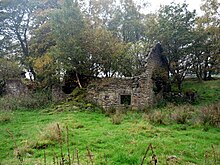Copperas works
 From Wikipedia - Reading time: 3 min
From Wikipedia - Reading time: 3 min

Copperas works are manufactories where copperas (iron(II) sulfate) is produced from pyrite, often obtained as a byproduct during coal mining, and iron. The history of producing green vitriol, as it was known, goes back hundreds of years in Scotland.[1] In 1814 the wool-producing city of Steubenville, Ohio had seven copperas-producing manufacturers.[2]
Pyrite has been used since classical times to manufacture copperas. Iron pyrite was heaped up and allowed to weather (an example of an early form of heap leaching). The acidic runoff from the heap was then boiled with iron to produce iron sulfate.[3]: 267 [4]: 152–153
Containment of leachate is important due to its toxicity; a fish kill that occurred in the 1890s in the Kanawha River was attributed to copperas solution release from the mines in Cannelton, West Virginia.[5]: 282
The "vitriolic waters of Fahlun" (Falun, Sweden), according to Murray (1844), annually produced "about 600 quintals of green vitriol" (sulfate of iron), as well as a "small quantity of blue vitriol" (sulfate of copper).[6] These may have been obtained through evaporation of the groundwater associated with mines in order to yield the crystalline form of copperas.[7]
References
[edit]- ^ Wilson, John (1812). General View of the Agriculture of Renfrewshire with Observations on the Means of Its Improvement, Drawn Up for the Consideration of the Board of Agriculture, and Internal Improvement. Paisley, Renfrewshire: Stephen Young. p. 281. Retrieved 30 December 2022 – via Google Books.
- ^ Sears, Robert, ed. (1848). A New and Popular Pictorial Description of the United States. New York: Robert Sears. pp. 506–508. Retrieved 30 December 2022 – via Internet Archive.
- ^ "Industrial England in the Middle of the Eighteenth Century". Nature. 83 (2113): 264–268. 1910-04-28. Bibcode:1910Natur..83..264.. doi:10.1038/083264a0. S2CID 34019869.
- ^ Wood, Henry Trueman (1910). "Chapter 6". Industrial England in the Middle of the Eighteenth Century. London: John Murray. pp. 129–157. hdl:2027/coo1.ark:/13960/t63497b2h. Retrieved 30 December 2022 – via Internet Archive.
- ^ Evermann, Barton Warren (1902). "Description of a New Species of Shad (Alosa ohiensis), with Notes on Other Food-Fishes of the Ohio River" (PDF). In Bowers, George M. (ed.). U.S. Commission of Fish and Fisheries, George M. Bowers, Commissioner, Part 27: Report of the Commissioner for the Year Ending June 30, 1901. Washington: Government Printing Office. pp. 275–288. Retrieved 30 December 2022 – via Penobscot Bay Watch.
- ^ Murray, Hugh (1844). "Part III, Book I, Chapter 15, Entry 3257. Sulphur and vitriol". The Encyclopædia of Geography: Comprising a Complete Description of the Earth, Physical, Statistical, Civil, and Political (Second ed.). London: Longman, Brown, Green, and Longmans. p. 768. Retrieved 30 December 2022 – via Google Books.
- ^ Helm-Clark, C.M. (28 October 2017). "Green Vitriol". The Gnarly Science Blog. Retrieved 30 December 2022.
 KSF
KSF